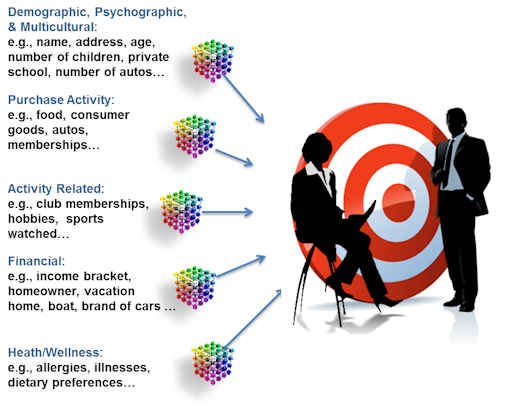Pamela Bartz, vice president at GT Software, and Michael Pernice (@MichaelPernice), GT Software’s regional sales manager, ask Chief Marketing Officers a very important question: “In today’s competitive, dynamic business landscape, what is the most prominent marketing medium where everyone is vying for customer attention?”[1] They offer a three-word answer: The digital marketplace. If you are wondering why they believe that, they explain:
“Because digital marketing is the most inexpensive and measurable means for expanding a customer base and increasing sales. It’s also at the forefront of improving customer experience because it offers a touch point that is highly customizable and targeted. And, in a climate where one missed step can send demanding consumers straight into the arms of the competition, its strategic use is becoming more critical.”
Understanding the landscape on which business is conducted is important; but, as Bartz and Pernice state, the landscape is only important because it is where highly targetable customers are found. Being able to target the right customer with the right offer at the right time benefits both the consumer and the seller. Charles E. Gaudet II (@charlesgaudet), a marketing consultant, likens targeted marketing to fishing. The best fishermen, he notes, don’t just pick a random spot on a stream or a lake and throw out a line. They know what kind of fish they want, what kind of bait those fish prefer, and they know where that particular kind of fish generally prefers to hang out.[2] In other words, catching a big trout in bass tournament won’t win you any prizes. “If you want to get the best return on your marketing dollars,” Gaudet writes, “you don’t want to rely on luck. Instead, you need to know exactly who your target customer is. In marketing, we call this your buyer persona.” Bartz and Pernice call it achieving a 360-degree view of the customer. They explain:
“Long gone are the days when targeting your marketing efforts by household income, zip code, age and sex can be considered sufficient, or successful. To compete in today’s digitally-driven world, CMOs in businesses across all industries must achieve a 360 degree view of the customer in order to successfully market to their specific needs and, in turn, drive revenue growth.”
Gaudet agrees with that sentiment. He writes, “Developing a buyer persona results in stronger and more cost effective marketing.” He then offers three reasons why understanding your customer achieves those results:
- It conveys a stronger message. If you aren’t sure exactly who your buyer is, it will invariably result in weak messaging. Untargeted marketing tries to target both everyone and no one in particular. When you have identified you buyer persona, you can use the language they are used to and provide a solution that seems tailor-made to their needs.
- It minimizes advertising waste. Understanding your buyer persona is very useful when purchasing advertising. Self-service advertising platforms on social media websites like LinkedIn and Facebook allow you to create highly targeted ads for very specific demographics. Knowing which magazine, television station or even mailing list to sell from allows you to better match the message with the audience most likely to bite. If you know your buyer persona is female, age 25-35, has a college education and loves to knit, you can ensure your ads appear only in front of people who fit this criteria.
- It helps you discover objections. If you understand your buyers’ most common objections to buying, you can address them in your marketing efforts. Sure, you can use testimonials, case studies, and examples of previous work to show that you’re someone who can deliver — but when those testimonials come from people who fit your buyer persona, they are seen as more credible. People tend to trust their peers.
In previous articles, I’ve noted that your ideal customer may not be the individual you thought it would be. That’s why analyzing data is so critical to identifying potential customers. Jim Joseph (@JimJosephExp), President of Americas and Chief Integrated Marketing Officer at Cohn & Wolfe, insists, “Knowing your target customer is the single most important job of any marketer, and it’s a job that never ends.”[3] Most analysts agree on two things when it comes to identifying potential customers. First, you should start with demographics; and, second, demographics are not enough. Demographic information includes things like gender, zip code, education, income, occupation, and interests. Gaudet adds, “Find out what problems your ideal customer is experiencing. What challenges are they facing and what results would they like to achieve? Find out what your buyer values in order to make a deeper connection.” The attached figure shows some of the other data that needs to be taken into consideration when developing a customer persona.
The staff at eMarketer reports that data-driven analytics are at the top of most marketing professionals priority lists.[4] The article notes that a study conducted by Econsultancy in association with Lynchpin, which was published last May, “found that, thanks to the rise of data-driven marketing, analytics were a hot topic among digital business professionals worldwide, many of whom were using them to improve personalization efforts. In fact, personalization and targeting were the second most popular requirements for analytics related to understanding the customer, cited by 53% of respondents. Tracking behavior across devices and channels, which can aid in personalization further down the road, ranked first.” Karl Greenberg (@KarlatMediapost) reports that another study, this one conducted by Forrester Consulting on behalf of Salesforce ExactTarget Marketing Cloud (now Salesforce Marketing Cloud), entitled “Refresh Your Approach to 1:1 Marketing,” found “that over three-quarters of digital marketers feel loyalty is affected directly by how well they do personalization.”[5] In a statement about the study, Woodson Martin (@woodson_martin), CMO of Salesforce Marketing Cloud, commented, “Today’s hyper-connected consumer requires companies to create personalized experiences and deliver value at each touch point to increase brand loyalty and drive sales.”
I like the way that Gaudet concluded his article. He wrote: “As Steven Wright once said, ‘There’s a fine line between fishing and just standing on the shore like an idiot.’ If you don’t want to just stand on the shore, it’s time to learn a little more about your customers.”
Footnotes
[1] Pamela Bartz and Michael Pernice, “How Accurate is Targeted Marketing if You Can’t See Your Target?” American Marketing Association, 25 September 2014.
[2] Charles E. Gaudet II, “How To Develop Your Buyer Persona And Reel In Better Customers,” Forbes, 28 October 2014.
[3] Jim Joseph, “The Most Important Piece of a Marketing Plan Is Your Targeted Customer,” Entrepreneur, 4 February 2015.
[4] Staff, “Marketers Just Want to Get to Know You (with Data),” eMarketer, 7 August 2014.
[5] Karl Greenberg, “Digital Marketers Beef Up On Personalization,” MediaPost, 18 August 2014.




